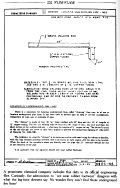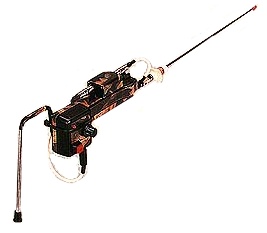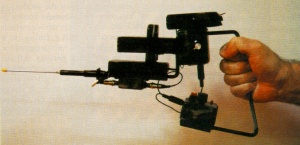DKL LifeGuard:
What's wrong with the picture?
Similarities to a dowsing rod
James Randi, in his highly entertaining book, "Flim-Flam!" (Buffalo, NY:
Prometheus Books, 1982), described a version of the dowsing rod which I believe is
the functional basis of the DKL LifeGuard.
 |
"...'dowsing rods,' which were one of the two
general varieties used by dowsers...consisted of...coat hangers straightened out to form
long L-shaped pieces.... The slightest tipping of the hand causes a rod to
swing about wildly. Deluxe versions of these rods have lubricated bearings in the
special handles." (p. 199) See diagram (p. 202) |
Having just finished reading Randi's book, I immediately recognized the DKL LifeGuard
as one of these "deluxe versions" of the dowsing stick. First hand testing of it
proved my theory. The "electronic" boxes were nothing but fancy "add-on's," designed
to fool people into thinking there are technical bases for the device. The
main functional basis of the DKL LifeGuards seems to be the basic free swinging
dowsing sticks.
Scientific nonsense
Dielectrophoresis:
Upon returning from the exhibition, I visited to our technical library and checked out the references which DKL cited as the basis for the LifeGuards. I have suspected that this is just a case of an application looking for a science. In other words, they had this idea of "modernizing" the dowsing rod, then went looking for a scientific theory that can back them up. After reading the references (papers by Dr. Herbert Pohl on Dielectrophoresis), I am convinced that this was so. Dielectrophoresis is the motion of electrically polarized matter in nonuniform fields. "Compared to the movement of charged particles (electrophoresis), it is a mild effect...." In fact, to demonstrate this effect in the laboratories, very strong electric fields had to be created, usually 300 to 1500 volts, across very small distances (millimeters). "Even these voltages, however, tend to cause sparking between the electrodes. Sparks are prevented by immersing the apparatus in nonconducting liquid." And the objects being moved by these strong voltages at extremely small ranges were talcum powder and other fine powders. (Herbert A. Pohl, "Nonuniform Electric Fields," Scientific American, Vol. 203, 1960.)
Using this principle, DKL claims that they can move a nearly 2 lb. mass (the LifeGuard), 500 yards away, and driven by the fields generated by your heart beat! We are talking no amplification here (no power source needed for the LifeGuard model 1). This is analogous to squirting some Raid on an elephant and expecting it to lay down dead. Oh, pplleeasse! [Note: DKL is redesigning the model 1--no doubt as a result of this line of criticism.]
(I also asked a well known expert in remote sensing--who would like his name withheld--for the reason why he did not include the LifeGuard in his recent book on sensors, and here is his response, quoted verbatim from his letter.)
Evolution of the LifeGuard
This is not the first "high-tech" dowsing rod Thomas Afilani has designed. Evidently, he loves to adapt the dowsing/divining rod to various uses, and had came up with quite a few gems. I was tipped off to this information by a reader of this web site, who did some research on Mr. Thomas Afilani. Here are some of his past inventions:
- The Thomas Electroscope aka. the Ver-Tex Receptor: (supposedly) for finding gold and silver. This one was a true gem, even its distributor disclaimed it. You must see their web page (item 3). It's so good that I will not desecrate it by quoting here. I was laughing so hard when I read it.
 The Trackman Game Locators: a device marketed to help hunters find their prey. It looks and acts exactly like the LifeGuard. I suspect that this device uses the same very short range electrostatic/proximity sensor design to fool people into believing that it also works at longer range (more on that on the next page).
The Trackman Game Locators: a device marketed to help hunters find their prey. It looks and acts exactly like the LifeGuard. I suspect that this device uses the same very short range electrostatic/proximity sensor design to fool people into believing that it also works at longer range (more on that on the next page).
From the Trackman web site came these interesting and humorous descriptions:
|
How does a Trackman Game Locator work? The antenna system locks on to an electrostatic field in the distance through antenna technology. Technically speaking, it is an antenna array referred to as a directional locator. The antenna system is a group of components, such as directors, reflectors, filters, and amplifiers, arranged to provide a specific desired matching characteristic to a field of opposite polarity, in order to produce an attraction. Providing the following criterias [sic] are fulfilled, an operator creates the electromotive force, conductor to ground, and the ability to be the inertia observer. A high degree of skill and proficiency can be achieved with practice of the instrument.
What does it track?
The Mini Predator is attracted to fur bearing animals and turKeys [sic], the Super Predator and the
Outfitter's only locate fur bearing animals, and the Turkeyhunter only picks up turkeys. All of the
instruments pick up humans, except the Turkeyhunter.
Does it locate animals underground? Yes
Who created the line of Trackman Game Locators? Thomas, a professional inventor with over thirty years of experience, created the machine after some business associates asked whether he could build an instrument to detect game for hunting.
How can I distinguish between humans and animals? Humans wear shoes which do not give them as good of a ground as an animal walking around with bare paws. Also, most hunters stay in one place when they hunt. Animals will move around.
When I sweep my Trackman, what is supposed to happen? When the Trackman is swept in a slow smooth manner to start, the operator should feel some
resistance, like the end of the antenna is magnetically attracted to something in the distance. Sweep it
from the other way. you should feel the same sensation. If you do not, then make the adjustments
previously mentioned.
What if the red light goes out? If the red light goes off on your amplification box, then the battery inside is probably dead.
The machine will still work, but for some individuals, they need that extra boost to receive a strong
signal. Some individuals may work better without the amplifier on. Just clip off the black tie and take
off the back of the box. Replace with the same brand of nine volt battery if possible. (Eveready Super
Heavy Duty) Try not to use an alkaline battery because there will be a difference in the performance of
the machine for some individuals. Find something such as another tie that can be bought just about
anywhere or try a rubber band to secure the amplifier box. Anyway, the battery should last a very long
time as long as the operator remembers to turn the machine off after every use. The Mini Predator does
not require a nine volt battery.
How can I become a better operator? People become better with Trackman Game Locators through practice. Try different grips. Try
different antenna lengths. Try different knob placements. Practice at home locating a friend, kids,
parents, dog, cat, etc in the home or outside. Watch how the Trackman can penetrate walls and other
barriers. Go out for a drive and find a place and sweep the instrument. If there is a turkey or deer pen
nearby, take it there and practice. Some individuals even use deer heads hanging on the wall to practice
with.
|
- The Manhunter: Again, the same idea was rehashed, this time for finding people. From the article "High-Technology Divining Rod Points Out Human Presence," Signal (Official Publication of AFCEA), Vol. 51, No. 2, October 1996, we have the following:
 Known as the Manhunter, the device detects the electrostatic field given off by a human being....
"It basically is a space-age divining rod," says Manhunter's inventor, Thomas Afilani.... the device can detect a human several hundred feet away from the operator. Known as the Manhunter, the device detects the electrostatic field given off by a human being....
"It basically is a space-age divining rod," says Manhunter's inventor, Thomas Afilani.... the device can detect a human several hundred feet away from the operator.
Manhunter sets up an electrostatic field similar to its intended target.... The user sweeps the device which points to the target when it recognizes a matching field. Reverse polarity causes an attraction which pulls the antenna towards the human.
However, since it detects electrostatic fields, it can also "be configured to detect inanimate materials." According to Afilani:
In one series of tests, the researchers placed a silver dollar in different rooms on the same floor of a building. In each trial, a system user in a closed room was able to determine the direction of the silver dollar despite several intervening walls and corridors. A similar experiment using gold produced similar results. (Uh huh! We have seen this concept proven in the Thomas Electroscope, haven't we?)
[Excerpts of this article also appeared in the Electrostatics Newsletter, March/April 1997 (HIGH-TECHNOLOGY DIVINING ROD DETECTS HUMAN PRESENCE).]
|
So, evidently, Mr. Afilani has been in this business a long time. First, we have the Thomas Electroscope, with its usual divining rod customers: treasure hunters and prospectors. Then a slightly different version, the Trackman, was offered to hunters for detecting fur- and feather-bearing animals, natually with emphasis on electrostatic charges. And finally, that design evolved into the Manhunter, which, according to Howard Sidman of DKL, was the prototype for the DKL LifeGuard. But something can't be a prototype for something else while the two are supposedly based on two completely different scientific principles!
The name switch from "Manhunter" to "LifeGuard" came when DKL was formed, and at the same time the "basic science" behind the device also changed. Aiming at a slightly more sophisticated group of victims, DKL realized that electrostatics would never fly. Any reasonably intelligent person would realize that you can't distinguish objects from their electrostatic charges, not mentioning the distances proposed. So in came something which sounded a little more obscure: dielectrophoresis.
They hoped that with basis in a little known property, nobody would bother to check out their claims. They were wrong. Mr. Afilani should have stuck with selling locators to hunters and gold prospectors. Trying to go big can sometimes bring scrutiny on oneself.
Other skeptical voices
- The Skeptic's Refuge's
article on DKL LifeGuard: This is one of the first exposé on the DKL LifeGuard. A follow-up essay lays out the case eloquently.
- On January 19, 1997, a gullible Washington Post reporter got conned into writing a very
naive article on the DKL LifeGuard. However, one interesting thing which the article revealed
was that, despite all the technical jargons used on DKL's brochures and web site, the device was
the brainchild of a completely uneducated non-technical person. Here's the Skeptic's respond.
- A web site by Dr. Keith Conover, a member of a search and rescue association, and his
letters to the FBI reporting DKL's scam.
- A letter from James Randi to DKL. James Randi has offered DKL a prize of U.S.$1.1 million if they could prove that the LifeGuards work. So far, DKL has ignored his offer. They know that it's impossible to fool a professional magician. Mr. Randi was actually too kind, suggesting to DKL that perhaps they are being fooled by the psychological "ideomotor" effect, which often afflicts many "dowsers" (the ones who actually believe in what they are doing, vs. the outright charlatans). In my opinion, the LifeGuards were too elaborately designed for that. Perhaps some operators and demonstrators were fooled by it, but the masters of this scheme were certainly not.
- Short summaries from the web site of the American Physical Society (the professional society of American physicists):
- The Skeptic News on 2 Nov. 1998 raised a very good point: "I'm not sure which possibility I find more disturbing -- that the Senator doesn't know what it is he is intervening on behalf of, or that he does."
- Another skeptical report by Investigative Research and Reporting, written by one who is experienced in dowsing.
- And of course, the definitive double-blind evaluation by Sandia National Laboratories, which we will discuss in another section.
Who are the victims?
There was a theory floating around the scientific community that the real target of this DKL scam was not the consumer, but their private investors. This was due to the long time lack of report of any DKL sales. But recently the Los Angeles Police Department bought 4 units (see the Los Angeles Times article), so evidently DKL is targeting both their investors and the consumers.
The ultimate financial victims of this scam are the tax payers. Due to the high prices ($7000 to $14000 a unit), the immediate targets of DKL are the federal, state, and local government, the military, and official fire and rescue units--people with big money (tax payers' money). Tragically, the real victims are the people in need that will die while the LifeGuards lead rescue searchers in random directions, and soldiers and police officers who will die depending on a piece of faulty equipment. Already, a Los Angeles Police Department unit is betting their lives on these devices. And DKL is depending on the anecdotal evidences to back them up, as did the Quadro Tracker before it. Quoting from the LA Times article:
|
One person who agrees with the company about the
value of LifeGuard is Lt. John Montanio of the Los
Angeles Interagency Metropolitan Police Apprehension
Crime Task Force, or LA IMPACT, a low-profile police
group focusing on major narcotics traffickers.
Montanio says the group has four of the devices and
is the only police agency in the country to use them
tactically. "It's been 100% effective for us," he said,
although its use has been appropriate only in a small
number of cases.
In one case, a month ago, LifeGuard helped find a
suspect in a large warehouse, he said. In a second,
involving a hostage situation in Industry, LifeGuard
showed where hostages were being held inside a house,
but also indicated a human presence at another corner of
the building. "I thought it was a mistake, but we later
found out there was a baby there," he said. |
The key words: 100% effective, "although its use has been appropriate only in a small number of cases." In other words, for the other cases where it was not effective, its use was not appropriate! This is the typical effect of the wish to believe. Discard conflicting data, just stick to the subset that works. And the last paragraph demonstrated it further: if at first it seems to be a mistake, look harder, there must be something to explain the discrepancy. It must work. We paid good money for this equipment.
This is why fortune tellers are so good.
Testimonials can never be used to prove anything. For example, if the police scanned a building for a burglar, and the LifeGuard did not register anything, do they conclude that the building is clear, that the LifeGuard worked, and that the thief just got away? A burglar in hiding would not pop up and volunteer, "Hey, you guys missed me, your scanner did not work. Nah nah NAH Nah nah!"
Tom Clancy, the techno-thriller author, also featured the DKL LifeGuard prominently in his recent novel, Rainbow Six. In the LA Times article, Tom Clancy admitted, "It's possible I
have been conned." The popularity of his novel provides fantastic promotional value for DKL, especially once the paperback version becomes available and the movie is made. I hope Mr. Clancy will take the responsible course of action and either remove the name "DKL LifeGuard" from any future printing of Rainbow Six, or place a disclaimer in the novel pointing out the questionable nature of the device.
Home | Next (The definitive report)

 The Trackman Game Locators: a device marketed to help hunters find their prey. It looks and acts exactly like the LifeGuard. I suspect that this device uses the same very short range electrostatic/proximity sensor design to fool people into believing that it also works at longer range (more on that on the next page).
The Trackman Game Locators: a device marketed to help hunters find their prey. It looks and acts exactly like the LifeGuard. I suspect that this device uses the same very short range electrostatic/proximity sensor design to fool people into believing that it also works at longer range (more on that on the next page).
 Known as the Manhunter, the device detects the electrostatic field given off by a human being....
"It basically is a space-age divining rod," says Manhunter's inventor, Thomas Afilani.... the device can detect a human several hundred feet away from the operator.
Known as the Manhunter, the device detects the electrostatic field given off by a human being....
"It basically is a space-age divining rod," says Manhunter's inventor, Thomas Afilani.... the device can detect a human several hundred feet away from the operator.